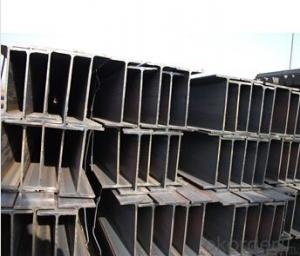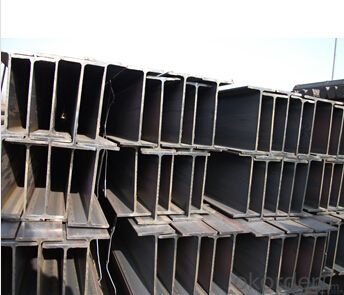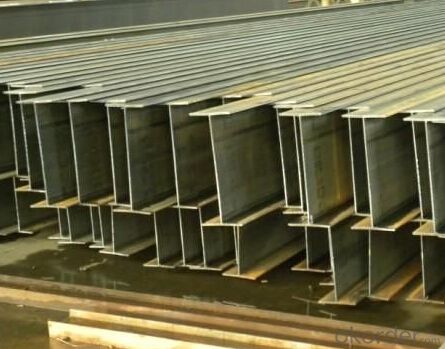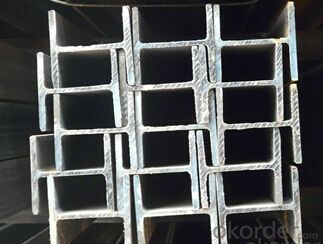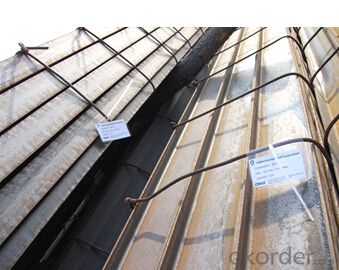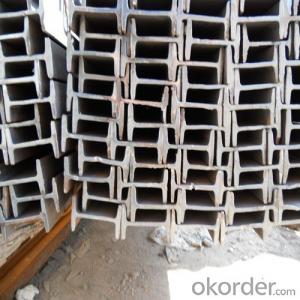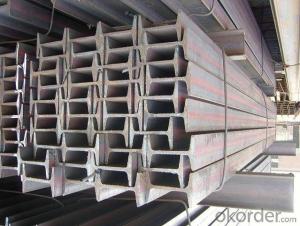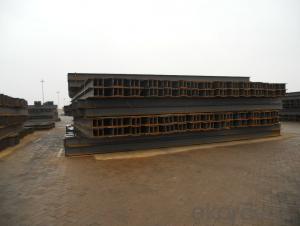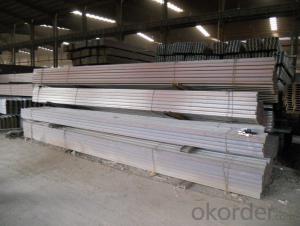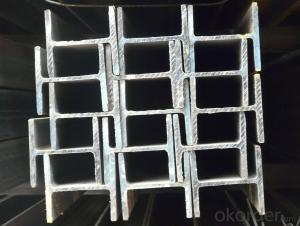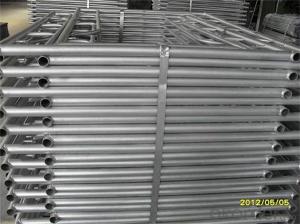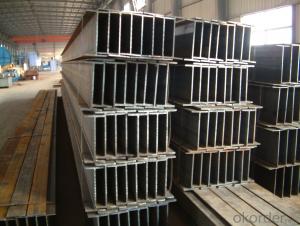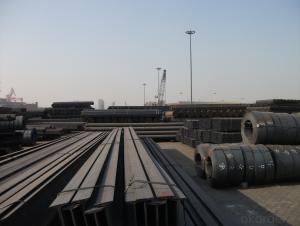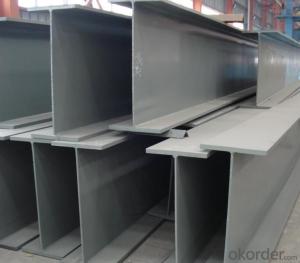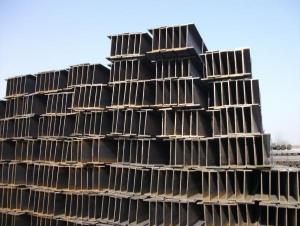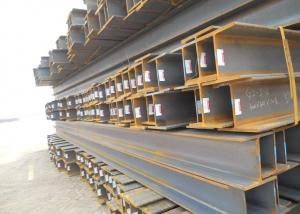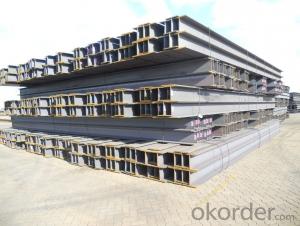GB Q235/Q275 Steel H-Beam
- Loading Port:
- China Main Port
- Payment Terms:
- TT or LC
- Min Order Qty:
- -
- Supply Capability:
- -
OKorder Service Pledge
OKorder Financial Service
You Might Also Like
Product Description:
OKorder is offering GB Q235/Q275 Steel H-Beam at great prices with worldwide shipping. Our supplier is a world-class manufacturer of steel, with our products utilized the world over. OKorder annually supplies products to European, North American and Asian markets. We provide quotations within 24 hours of receiving an inquiry and guarantee competitive prices.
Product Applications:
GB Q235/Q275 Steel H-Beam are ideal for structural applications and are widely used in the construction of buildings and bridges, and the manufacturing, petrochemical, and transportation industries.
Product Advantages:
OKorder's GB Q235/Q275 Steel H-Beam are durable, strong, and resist corrosion.
Main Product Features:
· Premium quality
· Prompt delivery & seaworthy packing (30 days after receiving deposit)
· Corrosion resistance
· Can be recycled and reused
· Mill test certification
· Professional Service
· Competitive pricing
Specifications of Hot Rolled Steel H-beam For Sale:
1. Standard: GB Standard
2. Grade: Q235/Q275
3. Length: 6m/12m
Size:
Size (mm) | Mass (Kg/m) | Size (mm) | Mass (Kg/m) |
150*150*7.0 | 31.1 | 200*100*5.5 | 20.9 |
198*99*4.5 | 17.8 | 194*150*6.0 | 29.9 |
Usage & Applications of Hot Rolled Steel H-beam For Sale
Commercial building structure ;Pre-engineered buildings; Machinery support structure; Prefabricated structure; Medium scale bridges; Ship-building structure.etc.
Production flow of Hot Rolled Steel H-beam For Sale
Material prepare (billet) —heat up—rough rolling—precision rolling—cooling—packing—storage and transportation
*If you would like to get our price, please inform us the size, standard/material and quantity. Thank you very much for your attention.
FAQ:
Q1: Why buy Materials & Equipment from OKorder.com?
A1: All products offered byOKorder.com are carefully selected from China's most reliable manufacturing enterprises. Through its ISO certifications, OKorder.com adheres to the highest standards and a commitment to supply chain safety and customer satisfaction.
Q2: How do we guarantee the quality of our products?
A2: We have established an advanced quality management system which conducts strict quality tests at every step, from raw materials to the final product. At the same time, we provide extensive follow-up service assurances as required.
Q3: How soon can we receive the product after purchase?
A3: Within three days of placing an order, we will begin production. The specific shipping date is dependent upon international and government factors, but is typically 7 to 10 workdays.
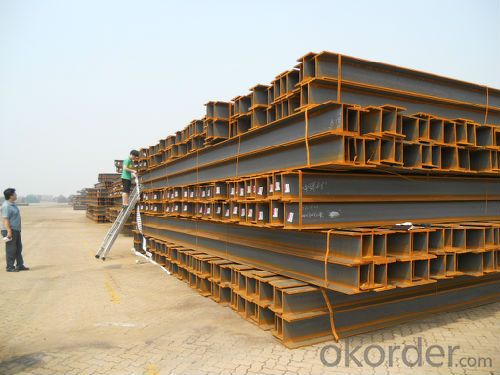
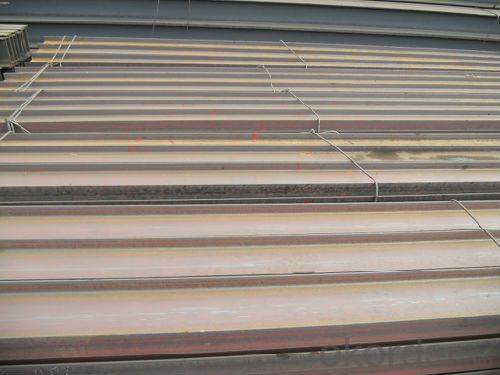
- Q: How do steel H-beams perform in dynamic loads?
- The structural characteristics of steel H-beams make them highly effective in withstanding dynamic loads. These beams have an H-shaped cross-section, providing excellent strength and rigidity that is ideal for applications where dynamic forces are a concern. When exposed to dynamic loads like impact or vibrations, steel H-beams show a remarkable ability to resist deformation and fatigue failure. The shape of the beams allows for even distribution of applied loads, minimizing stress concentrations and preventing localized failure points. This makes them highly reliable and durable under dynamic conditions. Additionally, steel has a high strength-to-weight ratio, meaning that H-beams can withstand significant dynamic loads while remaining relatively lightweight. This simplifies the structural design and reduces material and transportation costs. Furthermore, steel H-beams possess excellent elasticity, enabling them to absorb and dissipate energy from dynamic loads. This helps minimize potential damage or deformation to the structure and reduces the amplitude of vibrations. It also prevents the propagation of stress waves throughout the beam. In conclusion, steel H-beams are well-suited for dynamic loads due to their structural integrity, high strength-to-weight ratio, and elasticity. They can effectively resist deformation, fatigue, and impact caused by dynamic loads while maintaining their structural integrity and durability.
- Q: How are steel H-beams installed on construction sites?
- Steel H-beams are widely utilized in construction sites due to their strength and durability. To ensure their proper placement and stability, a series of steps are involved in the installation process. To begin with, the installation of steel H-beams necessitates the preparation of the construction site. This involves tasks such as clearing debris, leveling the ground, and verifying the foundation's ability to bear the weight of the beams. Once the site is prepared, the steel H-beams are typically delivered in sections. These sections are then hoisted into position utilizing cranes or other heavy machinery. Careful alignment and placement on temporary supports, known as cribbing, are conducted to keep the beams in place during installation. Subsequently, the beams are fastened together at the connection points, ensuring the formation of a solid and secure structure. Additional reinforcement may be achieved through welding to enhance the strength of the connections. Following the connection process, hydraulic jacks or other lifting equipment are employed to adjust the beams into the desired position. This guarantees that the beams are level and properly aligned with the rest of the structure. Once the beams are in their final position, they are permanently secured to the foundation or supporting structure using bolts or welding. This ensures their stability and prevents any potential shifting or movement over time. Lastly, the temporary supports, or cribbing, can be removed once the beams are firmly in place. This allows for the completion of other construction tasks, such as the installation of flooring or walls. In conclusion, the installation of steel H-beams on construction sites necessitates meticulous planning, coordination, and the utilization of suitable machinery. Adhering to industry guidelines and standards is crucial to ensure the structural integrity and safety of the building.
- Q: How do you calculate the deflection limits for steel H-beams?
- To calculate the deflection limits for steel H-beams, several factors need to be taken into consideration. The deflection limits are typically determined by the applicable building codes or industry standards. The following steps outline the general process of calculating the deflection limits: 1. Determine the relevant building code or industry standard: The deflection limits are usually specified by building codes or industry standards, such as the American Institute of Steel Construction (AISC) code. These codes provide guidelines for the maximum permissible deflection based on the intended use of the structure. 2. Identify the properties of the H-beam: Gather the necessary information about the H-beam, including its dimensions, material properties, and support conditions. This information is typically provided by the manufacturer or can be obtained from relevant design resources. 3. Calculate the moment of inertia: The moment of inertia is a measure of the beam's resistance to bending. It is calculated based on the beam's dimensions and geometry. The moment of inertia plays a crucial role in determining the deflection of the beam. 4. Determine the applied load: Identify the load or loads that will act on the H-beam. This could include dead loads, live loads, wind loads, or any other relevant loads as specified by the design requirements. 5. Apply the appropriate deflection formula: The specific deflection formula to be used will depend on the type of loading and support conditions. Common deflection formulas include the Euler-Bernoulli beam equation, which assumes linear elastic behavior, and the Timoshenko beam equation, which accounts for shear deformations. 6. Calculate the maximum allowable deflection: Using the deflection formula, input the relevant parameters such as the applied load, beam properties, and support conditions to calculate the deflection at various points along the beam. Compare the calculated deflection values to the deflection limits specified in the building code or industry standard. 7. Ensure compliance with deflection limits: If the calculated deflection exceeds the specified limits, adjustments need to be made to the beam's dimensions, material, or support conditions. This may involve increasing the beam size, using a higher-strength material, or adding additional support. It is important to note that the process of calculating deflection limits for steel H-beams can be complex and may require the expertise of a structural engineer or designer. Additionally, it is crucial to adhere to the applicable building codes and industry standards to ensure the safety and structural integrity of the project.
- Q: How do steel H-beams perform in structures with dynamic loads from machinery and equipment?
- Steel H-beams are a popular choice for structures with dynamic loads from machinery and equipment due to their excellent strength and durability. The inherent design of H-beams allows them to efficiently distribute the dynamic loads and provide stability to the structure. Their robustness helps to minimize vibrations and deflection, ensuring the safety and performance of the overall system.
- Q: Can steel H-beams be used in bridge construction?
- Yes, steel H-beams can be used in bridge construction. They are commonly used as primary load-bearing elements in bridge structures due to their high strength-to-weight ratio and excellent structural integrity. The H-shape provides added stability and resistance to bending, making it suitable for handling heavy loads and spanning long distances in bridge construction.
- Q: Are steel H-beams resistant to chemical spills?
- The resistance of steel H-beams to chemical spills can vary depending on the specific type of chemical. Steel is well-known for its durability and strength, making it highly resistant to many chemicals. However, there are certain corrosive chemicals that can potentially harm steel over time. To ensure maximum resistance to chemical spills, it is important to consider the properties of the chemicals and their potential impact on steel. For instance, highly corrosive acids or alkalis can gradually weaken the structural integrity of steel H-beams if not properly addressed. In such cases, it may be necessary to implement additional protective measures, such as corrosion-resistant coatings or regular maintenance, to prevent any long-term damage. In conclusion, although steel H-beams generally resist chemical spills, it is crucial to evaluate the specific chemicals involved and take appropriate precautions to maintain their structural integrity and longevity. Seeking advice from experts and adhering to industry standards is highly recommended to ensure proper protection against chemical spills.
- Q: Can steel H-beams be used in airport hangar construction?
- Yes, steel H-beams can be used in airport hangar construction. They are widely used in the construction industry due to their strength, durability, and ability to withstand heavy loads. H-beams provide structural support and are commonly used for framing and roof trusses in hangar construction.
- Q: What are the different types of connections used for steel H-beams?
- There are several different types of connections used for steel H-beams, including welded connections, bolted connections, and hybrid connections. Welded connections involve joining the H-beams using welding techniques, which provide a strong and durable connection. Bolted connections involve using bolts and nuts to secure the H-beams together, allowing for easy disassembly if needed. Hybrid connections combine both welding and bolting techniques to create a robust and flexible connection, offering the benefits of both methods. The choice of connection type depends on factors such as the load requirements, structural design, and construction preferences.
- Q: What are the different sizes of steel H-beams available in the market?
- The market offers a range of steel H-beams in various sizes, which may differ depending on the manufacturer and the project requirements. However, there are commonly found standard sizes. These sizes typically span from 100mm to 1,000mm in height, while their widths can vary between 50mm and 500mm. The length of the beams can also differ, with standard lengths typically falling within the range of 6 meters to 12 meters. Additionally, there are custom sizes available for more specific applications. To ascertain the precise sizes and specifications available in the market, it is advisable to consult with manufacturers or suppliers.
- Q: Can steel H-beams be used in sports stadiums and arenas?
- Yes, steel H-beams can be used in sports stadiums and arenas. They are commonly used in construction projects due to their strength and versatility. H-beams provide structural support and can withstand heavy loads, making them suitable for large-scale buildings like sports stadiums and arenas.
Send your message to us
GB Q235/Q275 Steel H-Beam
- Loading Port:
- China Main Port
- Payment Terms:
- TT or LC
- Min Order Qty:
- -
- Supply Capability:
- -
OKorder Service Pledge
OKorder Financial Service
Similar products
Hot products
Hot Searches
Related keywords
